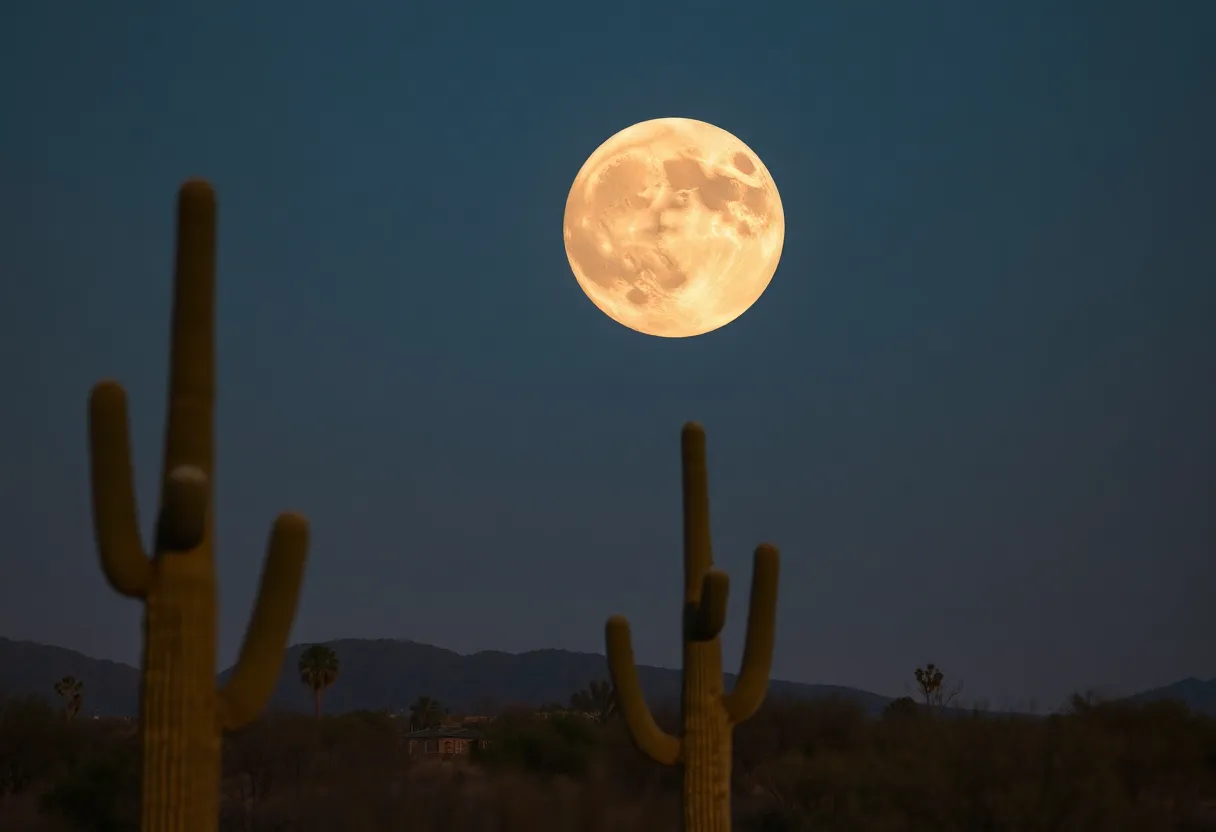Tucson, October 6, 2025
Tonight, Tucson will witness the first supermoon of 2025, known as the Hunter’s Moon. This lunar event, occurring at perigee, will appear 14% larger than usual. Optimal viewing will take place in locations like Saguaro National Park, where residents can enjoy ideal weather conditions and participate in community stargazing events. This notable celestial occurrence enhances the moon’s brightness, making it an appealing opportunity for astronomy enthusiasts and photographers alike.
First Supermoon of 2025 Visible in Tucson Tonight
Tucson, AZ — The first supermoon of 2025, known as the Hunter’s Moon, is set to rise on October 6, appearing 14% larger than usual due to its closer proximity to Earth. This celestial event is expected to draw attention from residents, with optimal viewing opportunities available after sunset at locations such as Saguaro National Park. The occurrence marks a significant astronomical highlight for the area, offering clear skies for observation.
Local experts have noted that the supermoon will enhance the moon’s visibility and brightness, making it a standout feature in the night sky. Individuals in Tucson are encouraged to seek out darker areas for the best experience, with Saguaro National Park recommended as a prime spot. This event coincides with favorable weather conditions, including expected clear skies, which will aid in stargazing activities planned at nearby observatories. Such gatherings provide an accessible way for the community to engage with the phenomenon, particularly appealing to those interested in photography and astronomy.
Details from recent updates indicate that the Hunter’s Moon will rise tonight, offering a spectacular view that is larger and more vivid compared to regular full moons. The moon’s increased size is attributed to its orbital position, bringing it closer to Earth than during typical cycles. This makes the event not only visually impressive but also a timely opportunity for educational outreach in the region. Local observatories are hosting related events to facilitate public viewing, emphasizing the moon’s role in seasonal astronomical patterns.
Supporting information highlights the preparation aspects for viewers. With clear skies forecasted, conditions are ideal for outdoor activities, allowing for unobstructed sights of the supermoon. Photography enthusiasts can take advantage of the enhanced brightness and size, potentially capturing detailed images of the lunar surface. These elements combine to make the event a community focal point, encouraging participation from families and individuals alike.
In the broader context, a supermoon occurs when a full moon coincides with the moon’s closest approach to Earth in its orbit, known as perigee. This results in the moon appearing larger and brighter than at other times. For Tucson, this event follows a series of local astronomical occurrences, adding to the area’s reputation for stargazing. The Hunter’s Moon, traditionally associated with the harvest season, serves as a natural spectacle that has been observed for centuries, blending cultural significance with scientific interest. While not unique, this year’s first supermoon provides a fresh opportunity for residents to connect with the cosmos.
Recent developments in Tucson have included preparations for such events, with local experts sharing insights on viewing techniques and safety. This includes advice on using appropriate equipment for moon observation to protect eyesight and enhance the experience. The event’s timing aligns with autumn activities, making it a seamless addition to community calendars. As one of the year’s key celestial highlights, it underscores the ongoing fascination with space phenomena in Arizona.
Expanding on the event’s appeal, the supermoon offers a chance for educational engagement. Topics such as lunar phases and orbital mechanics can be explored through this occurrence, providing context for why the moon appears differently at various times. In Tucson, this is particularly relevant given the region’s clear nights and access to natural parks, fostering a deeper appreciation for astronomy among the public.
Overall, the Hunter’s Moon on October 6 represents a notable event in Tucson’s astronomical calendar, drawing on both scientific explanations and community involvement. With its increased visibility and the promise of clear conditions, it stands as an accessible wonder for all ages, promoting a sense of wonder about the universe.
To ensure a comprehensive understanding, here’s how this event integrates with other local happenings. Recent reports have highlighted various Tucson activities, including cultural festivals and sports events, but the supermoon adds a natural element to the mix. This celestial display complements the community’s vibrant event scene, encouraging outdoor participation.
In summary, Tucson’s experience with the first supermoon of 2025 is poised to be memorable, with emphasis on safe and enjoyable viewing. The event’s details continue to be shared through local channels, keeping residents informed and excited.
FAQ
- What is the first supermoon of 2025? The first supermoon of 2025 is known as the Hunter’s Moon, rising tonight and appearing 14% larger due to its proximity to Earth.
- When and where can Tucsonans view the supermoon? Tucsonans are advised to view it from Saguaro National Park after sunset on October 6, 2025.
- What makes this supermoon special? It is a spectacular celestial event, with clear skies expected and stargazing events at local observatories, perfect for photography enthusiasts.
Key Features Chart
| Feature | Description |
|---|---|
| Name | Hunter’s Moon |
| Date | October 6, 2025 |
| Size Increase | 14% larger |
| Recommended Viewing Spot | Saguaro National Park |
| Weather Conditions | Clear skies expected |
| Best For | Photography enthusiasts and stargazing events |
Deeper Dive: News & Info About This Topic
HERE Resources
Tucson Residents to Witness the Harvest Moon




